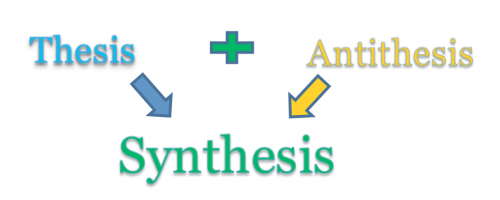Chapter 11: Developing a Convincing Argument
11.2 Dialectics
Learning Objectives
- Explain the components, practice, and benefits of dialectical thinking
- Conduct a dialect discussion to consider other points of view on your topic
As you read in Section 10.3: Being Critical, a strong persuasive essay will respectfully identify and discuss perspectives of the same topic. When you do this, you are presenting a well-rounded and complete discussion to your reader that shows you have critically thought about the topic and have been selective in choosing your points. As a result, there is a higher probably that you will convince your reader. The process of looking at multiple sides of a topic is called dialectics.
Dialectics is the act of using logical reasoning to combine, juxtapose, or synthesize opposing ideas to arrive at a strong conclusion.
The Components of Dialectics To begin the dialectic process, you first need to come up with an idea of what topic will be discussed; this is the thesis behind the discussion. Once you have determined your thesis, through various methods (the easiest being discussion with someone else), you will explore opposing sides to the topic, eventually discovering at least one antithesis. Combining those two perspectives, you can then make your own conclusions. Maybe this process will result in you standing by the original thesis, or maybe the antithesis is incredibly convincing and you will switch sides of the argument, or maybe you still believe the original thesis but accept there are other conditions that have credibility as well. This end result is called the synthesis: the blending of ideas. Essentially, the process would look like this:
Considering both your thesis and the discovered antithetical perspectives will help you to arrive at a wider view of a topic: one that has more credibility. Looking back to the persuasive essay samples you read in Section 10.4 and discussed in Self–Practice Exercise 11.5, consider to what degree the authors acknowledged opposing views. How did they justify their opinions? Consider how integrating dialectics into each of those arguments to a greater degree would have strengthened their points of view, ultimately making their arguments more convincing.
Self-Practice Exercise 11.6
H5P: Integrating Dialectics
Reviewing the Argument
Based on the thesis “Governments use capital punishment as an effective tool for deterring violent crime,” answer the following questions.
- What is your stance on this statement? To what extent do you agree/disagree?
- List all the ideas you can think of that would support your stance on the statement.
- List all the ideas you can think of that would counter your stance on the statement.
Embracing Perspectives
Discuss your answers with a partner (if you’re not in class, enlist a trusted friend). Can you expand either list based on what your partner has to say? Make those notes below.
After coming up with and considering the other perspective, has your point of view changed at all?
Do you still stick by your same point of view 100 percent? Or do you concede that there are valid points from the other perspective?
Self-Practice Exercise 11.7/Discussion 3
H5P: Dialectics
Reviewing Your Notes
For this exercise, you will need the work you did for Self-Practice Exercise 11.4. In addition, you might find it helpful to review Self-Practice Exercise 11.6 in order to remind yourself of what dialectic work looks like.
- Make a list of all the information you have that supports your thesis.
- Using your dialectic skills, work with a partner in class (or a trusted friend outside of class) to think through your position and any possible counter positions. Note what you learn from your discussions about the other side of the argument below.
- Did doing this exercise change your original point of view at all? Is there anything you can make concessions on being valid?
Revising Your Work
Doing this exercise may have changed your working thesis statement. Redraft your central argument below.
Now, revise your outline, using one or two of the counter points and incorporating them into your argument.


